Adult Safeguarding: Forms of Abuse, Strategies, and Independence
VerifiedAdded on 2020/06/04
|6
|1805
|24
Report
AI Summary
This report provides a comprehensive overview of adult safeguarding within the context of health and social care. It begins by defining adult abuse and detailing various forms of abuse, including physical, emotional, and institutional abuse, along with indicators of abusive situations. The report then explores factors that may lead to abuse, such as unemployment, lack of education, and mental illness, and discusses relevant legislation and regulations governing adult safeguarding. Furthermore, it outlines working strategies and procedures for reducing the risk of abuse, such as staff recruitment, training, and the implementation of protective processes. Finally, the report emphasizes the crucial role of supportive relationships in mitigating the risk of abuse, highlighting the importance of financial support, regular communication, and activities designed to build trust and confidence. The report concludes by summarizing the key findings and emphasizing the need for proactive measures to protect vulnerable adults and promote their independence.
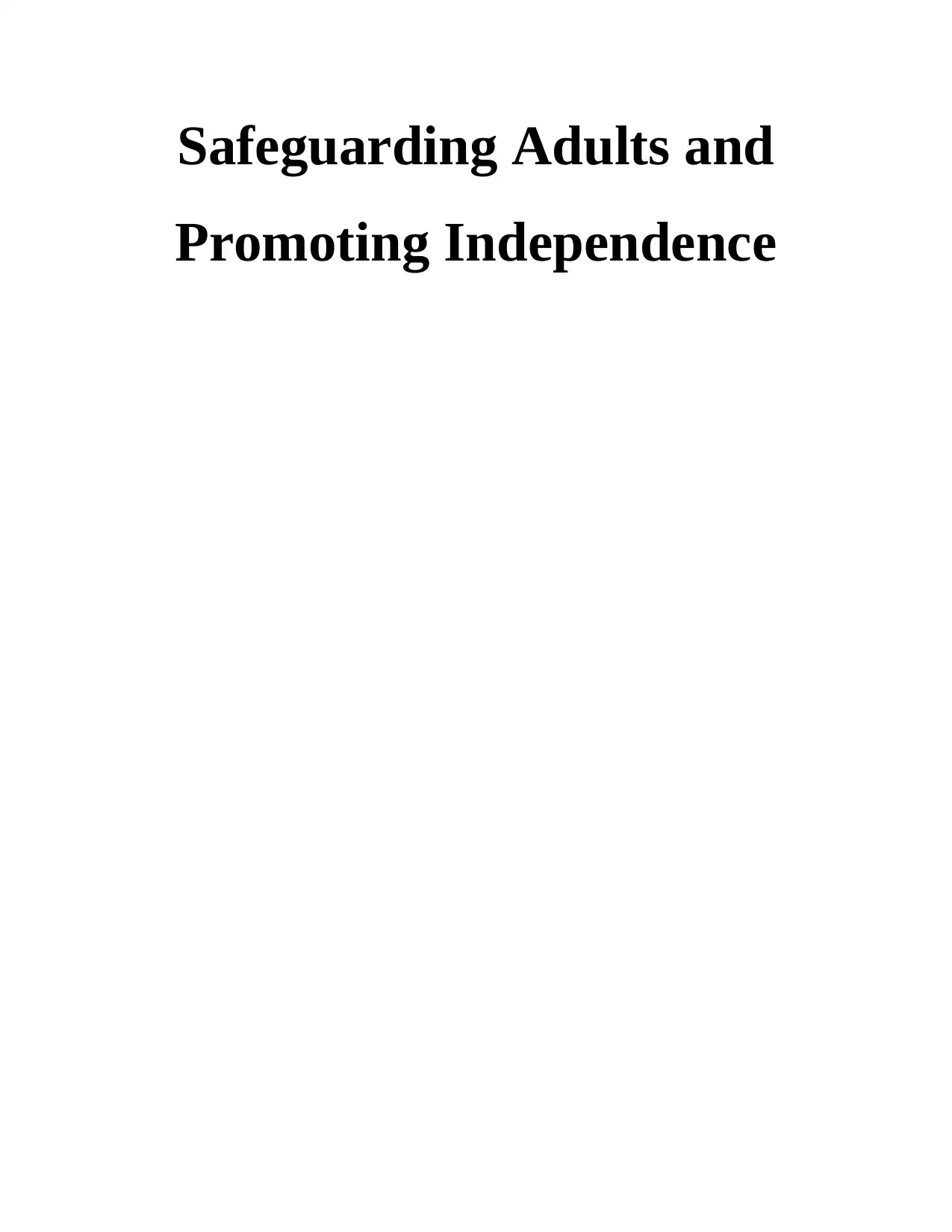
Safeguarding Adults and
Promoting Independence
Promoting Independence
Paraphrase This Document
Need a fresh take? Get an instant paraphrase of this document with our AI Paraphraser
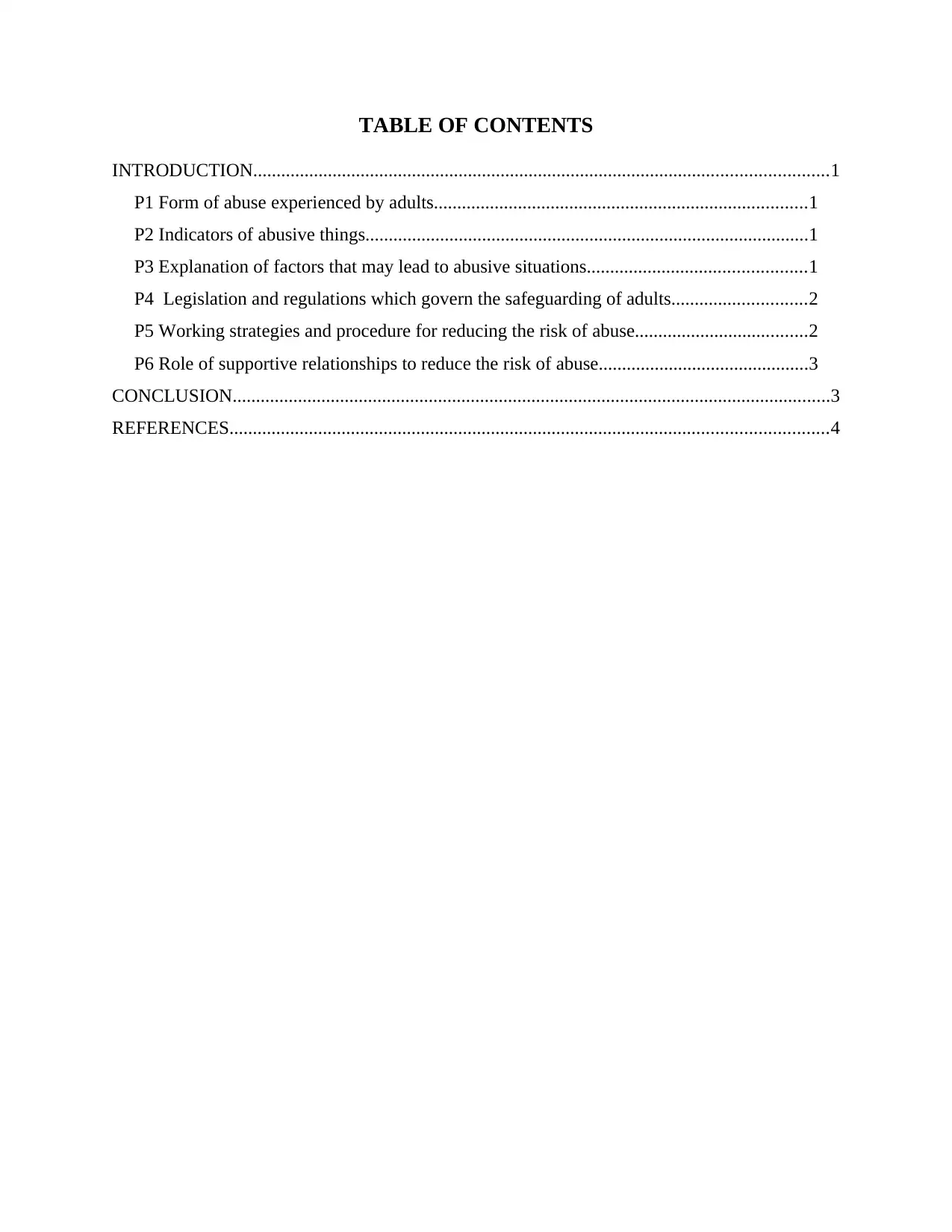
TABLE OF CONTENTS
INTRODUCTION...........................................................................................................................1
P1 Form of abuse experienced by adults................................................................................1
P2 Indicators of abusive things...............................................................................................1
P3 Explanation of factors that may lead to abusive situations...............................................1
P4 Legislation and regulations which govern the safeguarding of adults.............................2
P5 Working strategies and procedure for reducing the risk of abuse.....................................2
P6 Role of supportive relationships to reduce the risk of abuse.............................................3
CONCLUSION................................................................................................................................3
REFERENCES................................................................................................................................4
INTRODUCTION...........................................................................................................................1
P1 Form of abuse experienced by adults................................................................................1
P2 Indicators of abusive things...............................................................................................1
P3 Explanation of factors that may lead to abusive situations...............................................1
P4 Legislation and regulations which govern the safeguarding of adults.............................2
P5 Working strategies and procedure for reducing the risk of abuse.....................................2
P6 Role of supportive relationships to reduce the risk of abuse.............................................3
CONCLUSION................................................................................................................................3
REFERENCES................................................................................................................................4
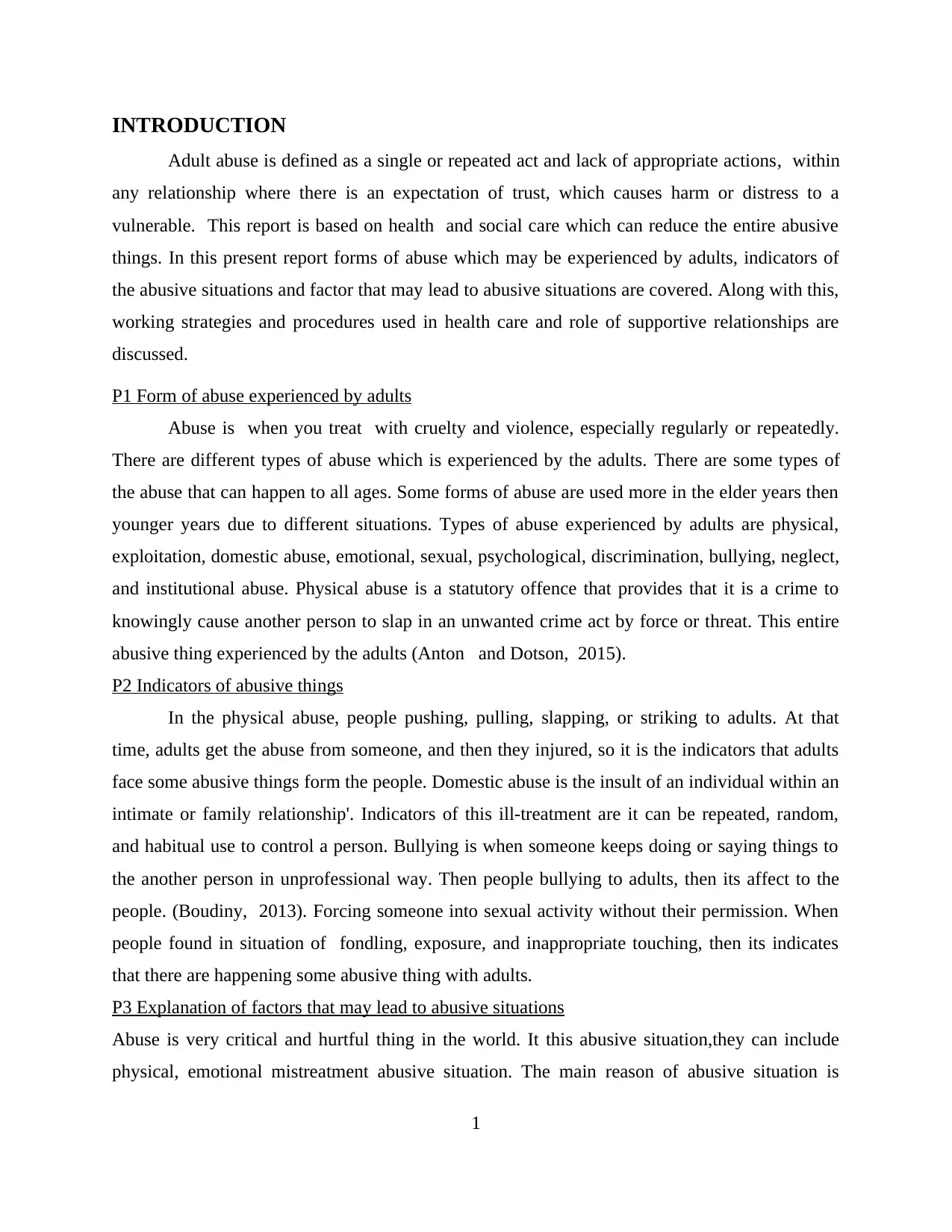
INTRODUCTION
Adult abuse is defined as a single or repeated act and lack of appropriate actions, within
any relationship where there is an expectation of trust, which causes harm or distress to a
vulnerable. This report is based on health and social care which can reduce the entire abusive
things. In this present report forms of abuse which may be experienced by adults, indicators of
the abusive situations and factor that may lead to abusive situations are covered. Along with this,
working strategies and procedures used in health care and role of supportive relationships are
discussed.
P1 Form of abuse experienced by adults
Abuse is when you treat with cruelty and violence, especially regularly or repeatedly.
There are different types of abuse which is experienced by the adults. There are some types of
the abuse that can happen to all ages. Some forms of abuse are used more in the elder years then
younger years due to different situations. Types of abuse experienced by adults are physical,
exploitation, domestic abuse, emotional, sexual, psychological, discrimination, bullying, neglect,
and institutional abuse. Physical abuse is a statutory offence that provides that it is a crime to
knowingly cause another person to slap in an unwanted crime act by force or threat. This entire
abusive thing experienced by the adults (Anton and Dotson, 2015).
P2 Indicators of abusive things
In the physical abuse, people pushing, pulling, slapping, or striking to adults. At that
time, adults get the abuse from someone, and then they injured, so it is the indicators that adults
face some abusive things form the people. Domestic abuse is the insult of an individual within an
intimate or family relationship'. Indicators of this ill-treatment are it can be repeated, random,
and habitual use to control a person. Bullying is when someone keeps doing or saying things to
the another person in unprofessional way. Then people bullying to adults, then its affect to the
people. (Boudiny, 2013). Forcing someone into sexual activity without their permission. When
people found in situation of fondling, exposure, and inappropriate touching, then its indicates
that there are happening some abusive thing with adults.
P3 Explanation of factors that may lead to abusive situations
Abuse is very critical and hurtful thing in the world. It this abusive situation,they can include
physical, emotional mistreatment abusive situation. The main reason of abusive situation is
1
Adult abuse is defined as a single or repeated act and lack of appropriate actions, within
any relationship where there is an expectation of trust, which causes harm or distress to a
vulnerable. This report is based on health and social care which can reduce the entire abusive
things. In this present report forms of abuse which may be experienced by adults, indicators of
the abusive situations and factor that may lead to abusive situations are covered. Along with this,
working strategies and procedures used in health care and role of supportive relationships are
discussed.
P1 Form of abuse experienced by adults
Abuse is when you treat with cruelty and violence, especially regularly or repeatedly.
There are different types of abuse which is experienced by the adults. There are some types of
the abuse that can happen to all ages. Some forms of abuse are used more in the elder years then
younger years due to different situations. Types of abuse experienced by adults are physical,
exploitation, domestic abuse, emotional, sexual, psychological, discrimination, bullying, neglect,
and institutional abuse. Physical abuse is a statutory offence that provides that it is a crime to
knowingly cause another person to slap in an unwanted crime act by force or threat. This entire
abusive thing experienced by the adults (Anton and Dotson, 2015).
P2 Indicators of abusive things
In the physical abuse, people pushing, pulling, slapping, or striking to adults. At that
time, adults get the abuse from someone, and then they injured, so it is the indicators that adults
face some abusive things form the people. Domestic abuse is the insult of an individual within an
intimate or family relationship'. Indicators of this ill-treatment are it can be repeated, random,
and habitual use to control a person. Bullying is when someone keeps doing or saying things to
the another person in unprofessional way. Then people bullying to adults, then its affect to the
people. (Boudiny, 2013). Forcing someone into sexual activity without their permission. When
people found in situation of fondling, exposure, and inappropriate touching, then its indicates
that there are happening some abusive thing with adults.
P3 Explanation of factors that may lead to abusive situations
Abuse is very critical and hurtful thing in the world. It this abusive situation,they can include
physical, emotional mistreatment abusive situation. The main reason of abusive situation is
1
⊘ This is a preview!⊘
Do you want full access?
Subscribe today to unlock all pages.

Trusted by 1+ million students worldwide
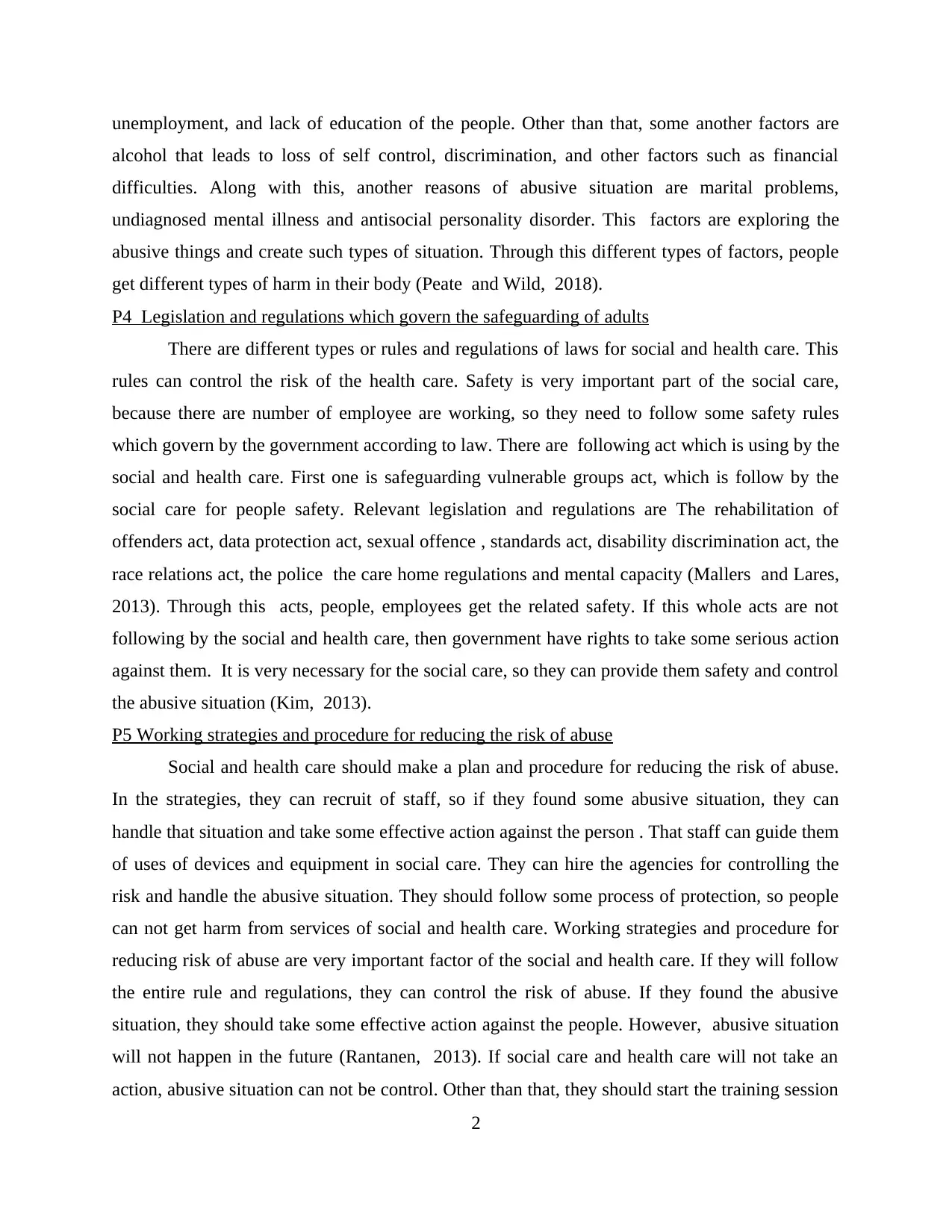
unemployment, and lack of education of the people. Other than that, some another factors are
alcohol that leads to loss of self control, discrimination, and other factors such as financial
difficulties. Along with this, another reasons of abusive situation are marital problems,
undiagnosed mental illness and antisocial personality disorder. This factors are exploring the
abusive things and create such types of situation. Through this different types of factors, people
get different types of harm in their body (Peate and Wild, 2018).
P4 Legislation and regulations which govern the safeguarding of adults
There are different types or rules and regulations of laws for social and health care. This
rules can control the risk of the health care. Safety is very important part of the social care,
because there are number of employee are working, so they need to follow some safety rules
which govern by the government according to law. There are following act which is using by the
social and health care. First one is safeguarding vulnerable groups act, which is follow by the
social care for people safety. Relevant legislation and regulations are The rehabilitation of
offenders act, data protection act, sexual offence , standards act, disability discrimination act, the
race relations act, the police the care home regulations and mental capacity (Mallers and Lares,
2013). Through this acts, people, employees get the related safety. If this whole acts are not
following by the social and health care, then government have rights to take some serious action
against them. It is very necessary for the social care, so they can provide them safety and control
the abusive situation (Kim, 2013).
P5 Working strategies and procedure for reducing the risk of abuse
Social and health care should make a plan and procedure for reducing the risk of abuse.
In the strategies, they can recruit of staff, so if they found some abusive situation, they can
handle that situation and take some effective action against the person . That staff can guide them
of uses of devices and equipment in social care. They can hire the agencies for controlling the
risk and handle the abusive situation. They should follow some process of protection, so people
can not get harm from services of social and health care. Working strategies and procedure for
reducing risk of abuse are very important factor of the social and health care. If they will follow
the entire rule and regulations, they can control the risk of abuse. If they found the abusive
situation, they should take some effective action against the people. However, abusive situation
will not happen in the future (Rantanen, 2013). If social care and health care will not take an
action, abusive situation can not be control. Other than that, they should start the training session
2
alcohol that leads to loss of self control, discrimination, and other factors such as financial
difficulties. Along with this, another reasons of abusive situation are marital problems,
undiagnosed mental illness and antisocial personality disorder. This factors are exploring the
abusive things and create such types of situation. Through this different types of factors, people
get different types of harm in their body (Peate and Wild, 2018).
P4 Legislation and regulations which govern the safeguarding of adults
There are different types or rules and regulations of laws for social and health care. This
rules can control the risk of the health care. Safety is very important part of the social care,
because there are number of employee are working, so they need to follow some safety rules
which govern by the government according to law. There are following act which is using by the
social and health care. First one is safeguarding vulnerable groups act, which is follow by the
social care for people safety. Relevant legislation and regulations are The rehabilitation of
offenders act, data protection act, sexual offence , standards act, disability discrimination act, the
race relations act, the police the care home regulations and mental capacity (Mallers and Lares,
2013). Through this acts, people, employees get the related safety. If this whole acts are not
following by the social and health care, then government have rights to take some serious action
against them. It is very necessary for the social care, so they can provide them safety and control
the abusive situation (Kim, 2013).
P5 Working strategies and procedure for reducing the risk of abuse
Social and health care should make a plan and procedure for reducing the risk of abuse.
In the strategies, they can recruit of staff, so if they found some abusive situation, they can
handle that situation and take some effective action against the person . That staff can guide them
of uses of devices and equipment in social care. They can hire the agencies for controlling the
risk and handle the abusive situation. They should follow some process of protection, so people
can not get harm from services of social and health care. Working strategies and procedure for
reducing risk of abuse are very important factor of the social and health care. If they will follow
the entire rule and regulations, they can control the risk of abuse. If they found the abusive
situation, they should take some effective action against the people. However, abusive situation
will not happen in the future (Rantanen, 2013). If social care and health care will not take an
action, abusive situation can not be control. Other than that, they should start the training session
2
Paraphrase This Document
Need a fresh take? Get an instant paraphrase of this document with our AI Paraphraser
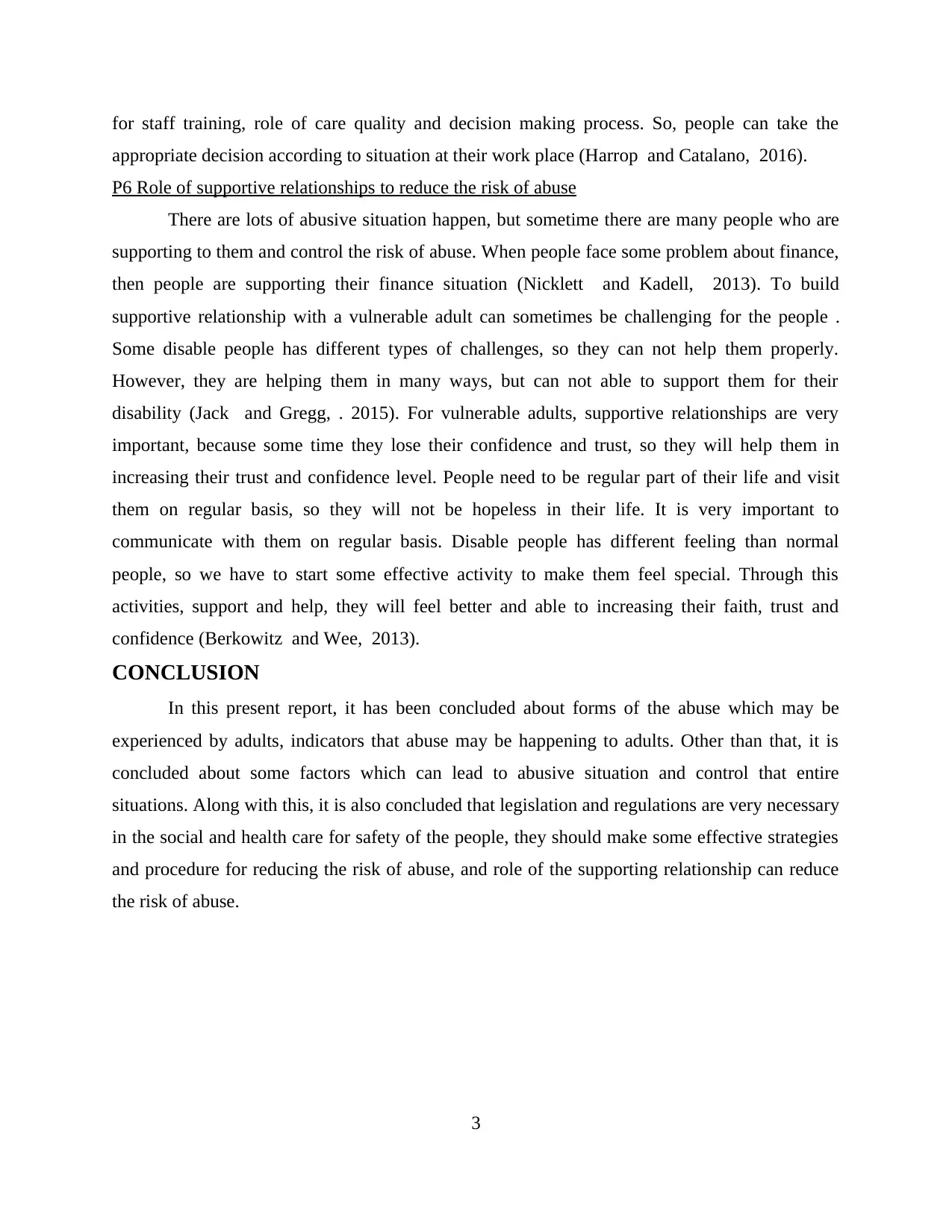
for staff training, role of care quality and decision making process. So, people can take the
appropriate decision according to situation at their work place (Harrop and Catalano, 2016).
P6 Role of supportive relationships to reduce the risk of abuse
There are lots of abusive situation happen, but sometime there are many people who are
supporting to them and control the risk of abuse. When people face some problem about finance,
then people are supporting their finance situation (Nicklett and Kadell, 2013). To build
supportive relationship with a vulnerable adult can sometimes be challenging for the people .
Some disable people has different types of challenges, so they can not help them properly.
However, they are helping them in many ways, but can not able to support them for their
disability (Jack and Gregg, . 2015). For vulnerable adults, supportive relationships are very
important, because some time they lose their confidence and trust, so they will help them in
increasing their trust and confidence level. People need to be regular part of their life and visit
them on regular basis, so they will not be hopeless in their life. It is very important to
communicate with them on regular basis. Disable people has different feeling than normal
people, so we have to start some effective activity to make them feel special. Through this
activities, support and help, they will feel better and able to increasing their faith, trust and
confidence (Berkowitz and Wee, 2013).
CONCLUSION
In this present report, it has been concluded about forms of the abuse which may be
experienced by adults, indicators that abuse may be happening to adults. Other than that, it is
concluded about some factors which can lead to abusive situation and control that entire
situations. Along with this, it is also concluded that legislation and regulations are very necessary
in the social and health care for safety of the people, they should make some effective strategies
and procedure for reducing the risk of abuse, and role of the supporting relationship can reduce
the risk of abuse.
3
appropriate decision according to situation at their work place (Harrop and Catalano, 2016).
P6 Role of supportive relationships to reduce the risk of abuse
There are lots of abusive situation happen, but sometime there are many people who are
supporting to them and control the risk of abuse. When people face some problem about finance,
then people are supporting their finance situation (Nicklett and Kadell, 2013). To build
supportive relationship with a vulnerable adult can sometimes be challenging for the people .
Some disable people has different types of challenges, so they can not help them properly.
However, they are helping them in many ways, but can not able to support them for their
disability (Jack and Gregg, . 2015). For vulnerable adults, supportive relationships are very
important, because some time they lose their confidence and trust, so they will help them in
increasing their trust and confidence level. People need to be regular part of their life and visit
them on regular basis, so they will not be hopeless in their life. It is very important to
communicate with them on regular basis. Disable people has different feeling than normal
people, so we have to start some effective activity to make them feel special. Through this
activities, support and help, they will feel better and able to increasing their faith, trust and
confidence (Berkowitz and Wee, 2013).
CONCLUSION
In this present report, it has been concluded about forms of the abuse which may be
experienced by adults, indicators that abuse may be happening to adults. Other than that, it is
concluded about some factors which can lead to abusive situation and control that entire
situations. Along with this, it is also concluded that legislation and regulations are very necessary
in the social and health care for safety of the people, they should make some effective strategies
and procedure for reducing the risk of abuse, and role of the supporting relationship can reduce
the risk of abuse.
3
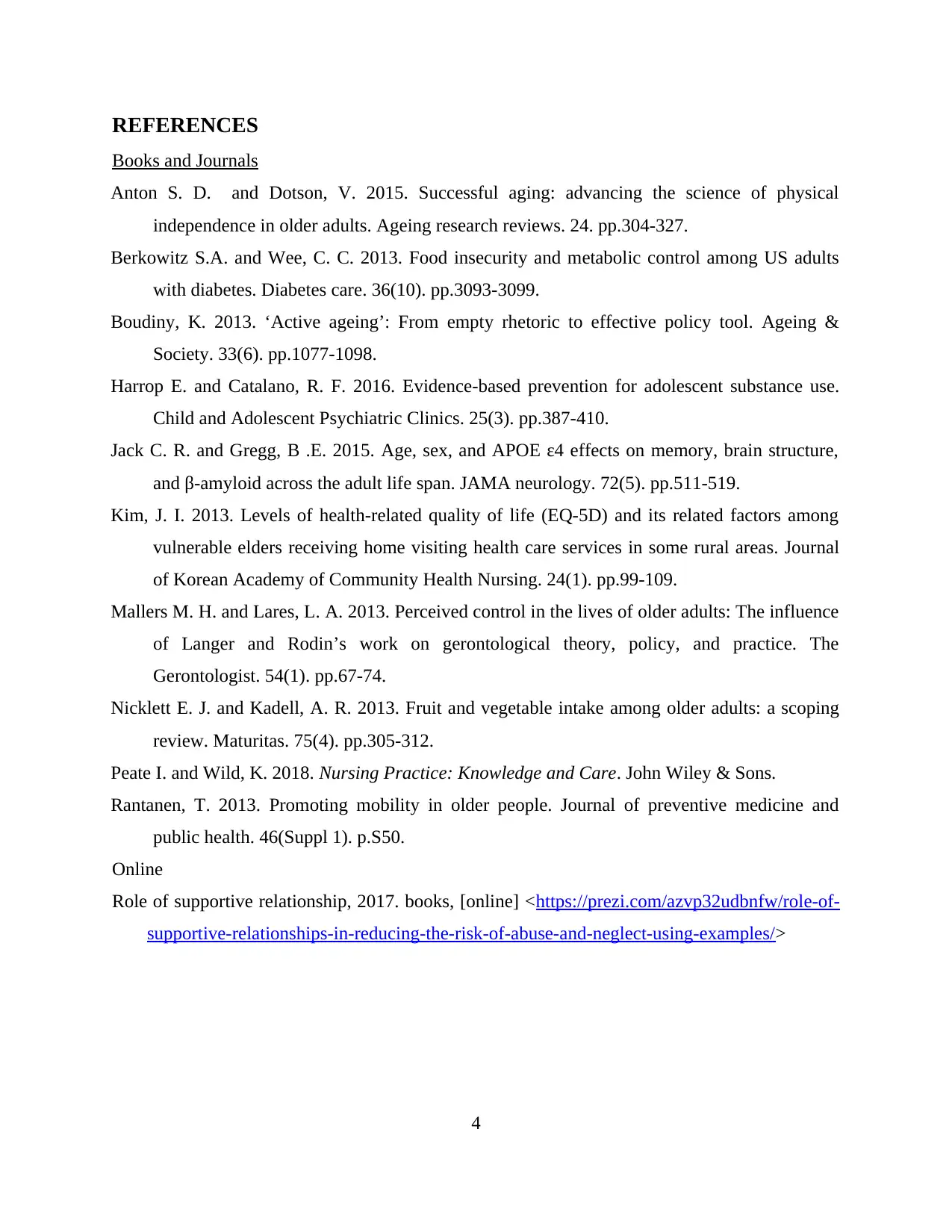
REFERENCES
Books and Journals
Anton S. D. and Dotson, V. 2015. Successful aging: advancing the science of physical
independence in older adults. Ageing research reviews. 24. pp.304-327.
Berkowitz S.A. and Wee, C. C. 2013. Food insecurity and metabolic control among US adults
with diabetes. Diabetes care. 36(10). pp.3093-3099.
Boudiny, K. 2013. ‘Active ageing’: From empty rhetoric to effective policy tool. Ageing &
Society. 33(6). pp.1077-1098.
Harrop E. and Catalano, R. F. 2016. Evidence-based prevention for adolescent substance use.
Child and Adolescent Psychiatric Clinics. 25(3). pp.387-410.
Jack C. R. and Gregg, B .E. 2015. Age, sex, and APOE ε4 effects on memory, brain structure,
and β-amyloid across the adult life span. JAMA neurology. 72(5). pp.511-519.
Kim, J. I. 2013. Levels of health-related quality of life (EQ-5D) and its related factors among
vulnerable elders receiving home visiting health care services in some rural areas. Journal
of Korean Academy of Community Health Nursing. 24(1). pp.99-109.
Mallers M. H. and Lares, L. A. 2013. Perceived control in the lives of older adults: The influence
of Langer and Rodin’s work on gerontological theory, policy, and practice. The
Gerontologist. 54(1). pp.67-74.
Nicklett E. J. and Kadell, A. R. 2013. Fruit and vegetable intake among older adults: a scoping
review. Maturitas. 75(4). pp.305-312.
Peate I. and Wild, K. 2018. Nursing Practice: Knowledge and Care. John Wiley & Sons.
Rantanen, T. 2013. Promoting mobility in older people. Journal of preventive medicine and
public health. 46(Suppl 1). p.S50.
Online
Role of supportive relationship, 2017. books, [online] <https://prezi.com/azvp32udbnfw/role-of-
supportive-relationships-in-reducing-the-risk-of-abuse-and-neglect-using-examples/>
4
Books and Journals
Anton S. D. and Dotson, V. 2015. Successful aging: advancing the science of physical
independence in older adults. Ageing research reviews. 24. pp.304-327.
Berkowitz S.A. and Wee, C. C. 2013. Food insecurity and metabolic control among US adults
with diabetes. Diabetes care. 36(10). pp.3093-3099.
Boudiny, K. 2013. ‘Active ageing’: From empty rhetoric to effective policy tool. Ageing &
Society. 33(6). pp.1077-1098.
Harrop E. and Catalano, R. F. 2016. Evidence-based prevention for adolescent substance use.
Child and Adolescent Psychiatric Clinics. 25(3). pp.387-410.
Jack C. R. and Gregg, B .E. 2015. Age, sex, and APOE ε4 effects on memory, brain structure,
and β-amyloid across the adult life span. JAMA neurology. 72(5). pp.511-519.
Kim, J. I. 2013. Levels of health-related quality of life (EQ-5D) and its related factors among
vulnerable elders receiving home visiting health care services in some rural areas. Journal
of Korean Academy of Community Health Nursing. 24(1). pp.99-109.
Mallers M. H. and Lares, L. A. 2013. Perceived control in the lives of older adults: The influence
of Langer and Rodin’s work on gerontological theory, policy, and practice. The
Gerontologist. 54(1). pp.67-74.
Nicklett E. J. and Kadell, A. R. 2013. Fruit and vegetable intake among older adults: a scoping
review. Maturitas. 75(4). pp.305-312.
Peate I. and Wild, K. 2018. Nursing Practice: Knowledge and Care. John Wiley & Sons.
Rantanen, T. 2013. Promoting mobility in older people. Journal of preventive medicine and
public health. 46(Suppl 1). p.S50.
Online
Role of supportive relationship, 2017. books, [online] <https://prezi.com/azvp32udbnfw/role-of-
supportive-relationships-in-reducing-the-risk-of-abuse-and-neglect-using-examples/>
4
⊘ This is a preview!⊘
Do you want full access?
Subscribe today to unlock all pages.

Trusted by 1+ million students worldwide
1 out of 6
Related Documents
Your All-in-One AI-Powered Toolkit for Academic Success.
+13062052269
info@desklib.com
Available 24*7 on WhatsApp / Email
![[object Object]](/_next/static/media/star-bottom.7253800d.svg)
Unlock your academic potential
Copyright © 2020–2025 A2Z Services. All Rights Reserved. Developed and managed by ZUCOL.





